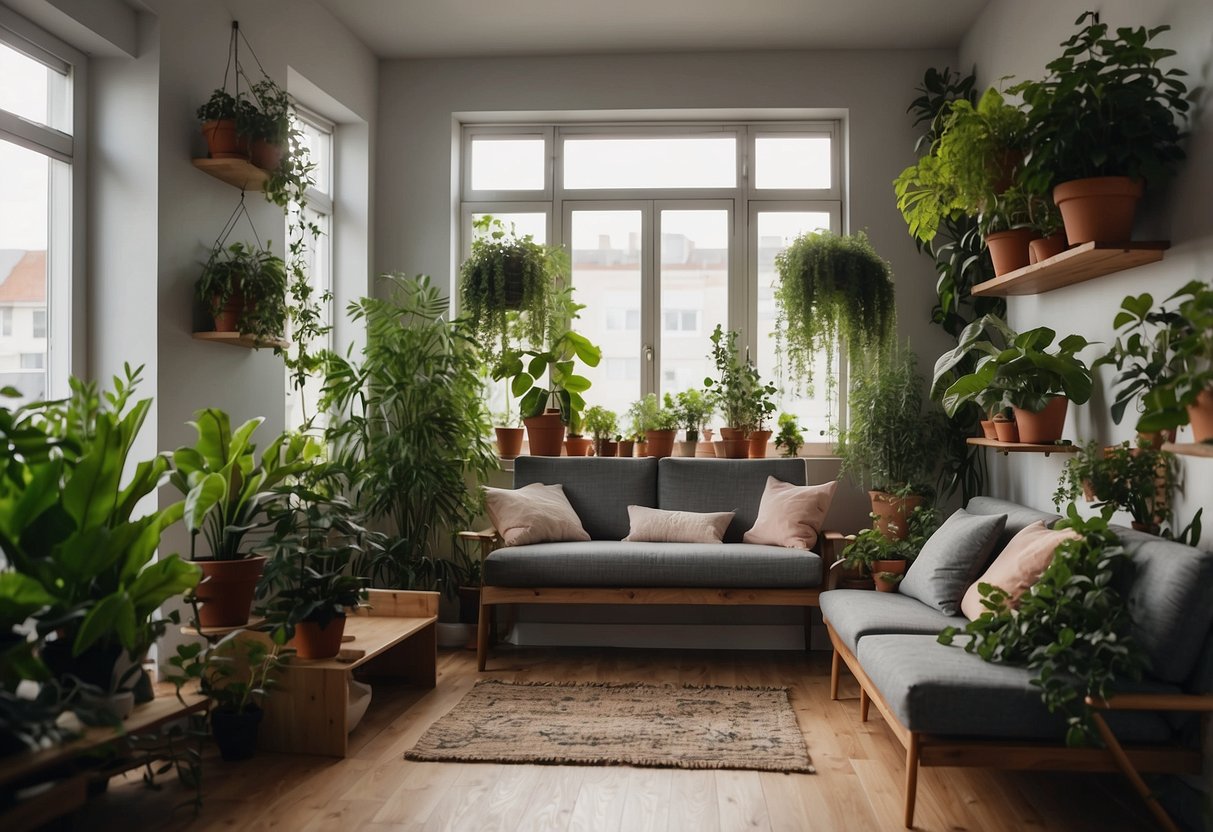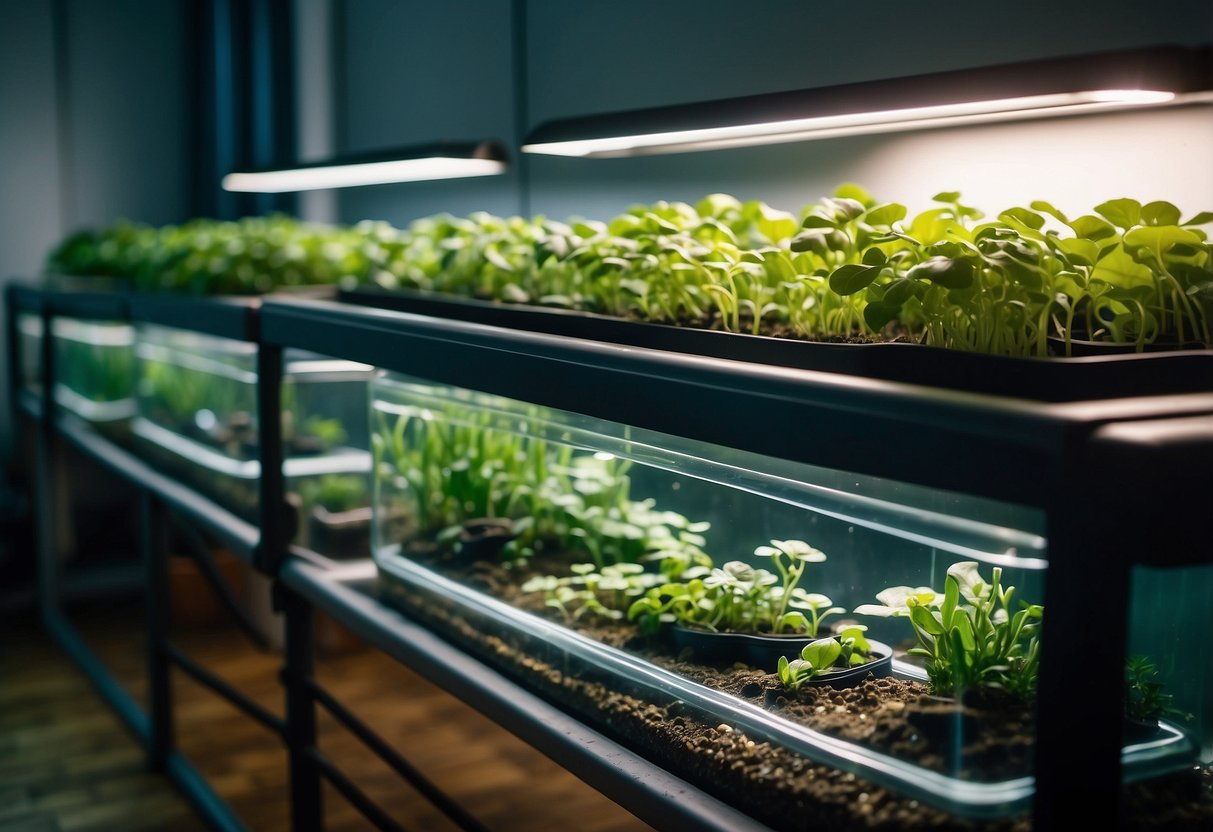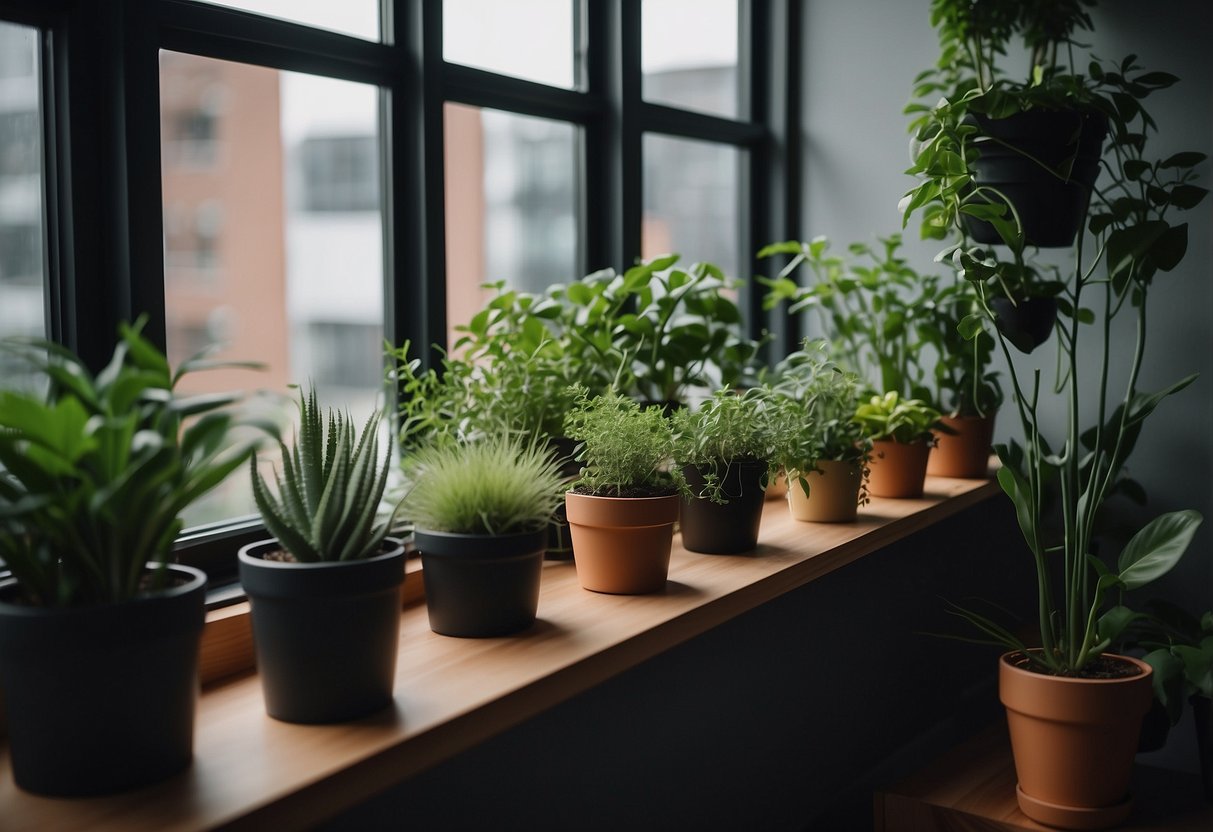Indoor Garden Ideas Apartment: Creative and Space-Saving Solutions
Creating an indoor garden in your apartment is a fantastic way to bring nature into your living space, even if you have limited room. Whether you want to grow fresh herbs for cooking or simply enjoy the beauty of greenery, there are plenty of ways to design an indoor garden that fits your lifestyle and space.

You’ll find that indoor gardening can be both relaxing and rewarding, adding a vibrant touch to your home. With the right plants and a bit of creativity, you can transform any corner of your apartment into a green oasis.
1) Vertical Herb Garden

A vertical herb garden is perfect for your apartment. You can use it to grow fresh herbs without taking up much space.
Consider using hanging shelves with terra-cotta pots, which is both simple and attractive. Drill circular holes in pine boards and string them up with rope, creating a unique display.
Another option is turning an Ikea bar cart into a mobile vertical herb garden. This is great for moving your garden around to always have your fresh herbs close by. For more ideas, you can visit 40 DIY Vertical Herb Garden Ideas.
2) Hanging Planters

Hanging planters bring a touch of nature indoors and can save space. They’re perfect for apartments where floor space is limited. You can hang them near windows for natural light.
Plants like the Arrowhead Plant are great for hanging planters. They have trailing vines that can create a beautiful cascading effect.
Using materials like wood slices or even disco balls for your planters can add a unique flair. Check out more creative DIY ideas at Balcony Garden Web.
3) Window Sill Succulent Garden

A window sill succulent garden is perfect for brightening up your space. Succulents need lots of sunlight, making a sunny window the ideal spot for them.
You can use fun and creative containers like tea cups or ceramic planters to add style. You’ll enjoy how easy it is to care for these hardy plants. Check out more succulent windowsill ideas for inspiration.
4) DIY Terrarium

Creating a DIY terrarium is a fun way to bring a small piece of nature into your apartment. Start with a clear glass container. It can be anything from a fishbowl to a jar.
Next, add some small stones for drainage. Then, layer activated charcoal to keep things fresh.
Fill with potting soil and choose your plants. Succulents and moss are great options. Place your terrarium in bright, indirect light and mist it occasionally. Enjoy your mini garden!
5) Ladder Shelf Garden

A ladder shelf garden is a great way to grow plants in your apartment. You can use an old wooden ladder or buy a new one. Paint it a fun color to match your decor.
Place the ladder in a sunny spot. Put potted plants on each step. This setup saves space and adds a nice green touch to your home.
6) Aquaponics System

An aquaponics system is a great way to grow plants and raise fish in your apartment. It’s a closed-loop system where fish waste provides nutrients for plants, and the plants filter the water for the fish.
For small spaces, consider the Go Green Aquaponics Kit, which is great for both beginners and enthusiasts. It’s compact yet effective.
Another option is the Kingro 5 in 1 Aquaponics System. It includes lighting and is perfect for indoor use.
7) Indoor Greenhouse

An indoor greenhouse is a fantastic way to grow plants in your apartment. You can create one with seeds, planting trays, and soil. For a bit extra, add a timer, grow light, and shelves for multiple plants.
A mini greenhouse like the IKEA Åkerbär could be perfect for small spaces. This is a great option if you’re looking to keep a few plants indoors year-round.
8) Wall-mounted Planters

Wall-mounted planters are a great way to add greenery to your apartment without taking up floor space. You can find a variety of styles, like the durable cement planters that can be used both indoors and outdoors.
For a rustic look, try a wooden ladder with hanging buckets, which can hold herbs and flowers. This setup creates a charming, farmhouse feel.
Consider using self-watering containers to make plant care easier. Plants with large leaves, like Monstera, mixed with delicate ferns, can make a stunning indoor plant wall.
9) Grow Light Setup

Setting up grow lights in your apartment is a fantastic way to ensure your plants get the light they need.
LED grow lights are popular because they are energy-efficient and last a long time. For a budget-friendly option, you can use LED strip lights powered by a computer power.
Fluorescent grow lights, like T5 or T8 tubes, are also useful if you are growing a few plants. If you prefer something simpler, a compact fluorescent light (CFL) can do the job.
10) Smart Garden

A smart garden is perfect for tech-savvy plant lovers.
You can control everything with an app on your phone, from watering schedules to lighting.
Systems like the Click & Grow Smart Garden 3 allow you to grow herbs and salad greens easily.
A bit more advanced, the Rise Gardens Single Family Garden can even adapt to larger plants.
Choosing the Right Plants

Picking the right plants for your apartment garden depends on the light available and the purpose of the plants. Some plants thrive in low-light conditions, while others like herbs need more attention but can be quite rewarding.
Low-Light Plants
For spaces with limited light, you can choose plants that require minimal sunlight. Philodendrons are adaptable and easy to care for, making them perfect for beginners. They grow well even in low light and are quite resilient.
Spider Plants are another great option. They are hardy and can tolerate neglect, making them ideal for busy individuals. Spider Plants also help improve air quality.
Pothos (Epipremnum aureum) is another wonderful choice. It’s a hardy plant known for its ability to thrive in dim environments. Its trailing vines make it a beautiful decorative element.
These plants not only survive with little sunlight but also add a touch of greenery to your apartment, making it feel more inviting.
Herbs for Indoor Gardens
Growing herbs in your apartment can be a delightful experience. Basil is a popular herb that grows well indoors. It loves sunlight, so place it near a sunny window.
Mint is another excellent herb for indoor gardens. It grows quickly and can be used in various dishes and drinks. Just make sure to prune it regularly.
Chives are easy to grow and add a mild onion flavor to your meals. They don’t need much sunlight but benefit from being near a bright window.
Thyme is a versatile herb that’s perfect for your indoor garden. It requires only a small pot and can thrive with moderate care.
Choosing the right herbs not only provides fresh ingredients for your cooking but also fills your apartment with pleasant aromas.
Creating an Ideal Growing Environment

Ensuring your indoor garden thrives involves careful attention to factors like lighting, temperature, and humidity.
Lighting Solutions for Small Spaces
Lighting is crucial for indoor plants since they often lack natural sunlight. You can use LED grow lights which provide the necessary spectrum for plant growth. These lights are energy-efficient and can be adjusted to fit small spaces.
Placing plants near windows is another good option. East or south-facing windows are ideal as they get the most sunlight. Use sheer curtains to prevent scorching.
For those with limited window space, try compact fluorescent lamps (CFLs). They’re inexpensive and can be placed close to plants. Use a mix of warm and cool white bulbs for balanced light.
Temperature and Humidity Control
Maintaining the right temperature and humidity is vital. Most indoor plants thrive in temperatures between 60°F and 75°F. Avoid placing plants near drafty windows or heat sources like radiators.
Humidity is another key aspect. Many indoor plants prefer humidity levels between 40-60%.
Humidifiers are excellent for increasing humidity, especially in dry climates. Grouping plants together can also help create a micro-habitat that retains moisture.
You can use humidity trays filled with water and pebbles. Place the plants on top without letting their roots sit in water directly. Regular misting with a spray bottle also works, but be cautious not to overdo it to prevent mold.
Maintaining Your Indoor Garden

Keeping your indoor garden thriving involves regular watering and effective pest management. Proper techniques in these areas will ensure your plants stay healthy and vibrant.
Watering Tips
When watering your indoor garden, less can be more. Overwatering is a common mistake. Use your finger to check soil moisture. If it’s dry up to 1-2 inches deep, it’s time to water. Water thoroughly but ensure the pots have drainage holes to prevent root rot.
Use a spray bottle for plants that prefer higher humidity like ferns and moss. Grouping plants together can create a micro-habitat with higher humidity levels. For a low-maintenance option, consider self-watering pots.
Morning is the best time to water as it allows plants to dry out during the day, reducing the risk of mold. Adjust watering frequency based on the season and plant needs.
Pest Management
Pests can be a challenge indoors. Regularly inspect your plants for common pests such as aphids, spider mites, and whiteflies. Look under leaves and at soil level.
If you spot pests, start with a gentle approach like wiping leaves with a damp cloth. For more severe infestations, insecticidal soap or neem oil can be effective. Be sure to follow package instructions carefully.
Keep your plants clean by dusting leaves and removing dead foliage. This reduces places where pests can hide. Quarantine new plants before adding them to your indoor garden to prevent introducing pests.
Remember, healthy plants are less likely to attract pests. Regular care and proper watering will keep your indoor garden in top condition.







